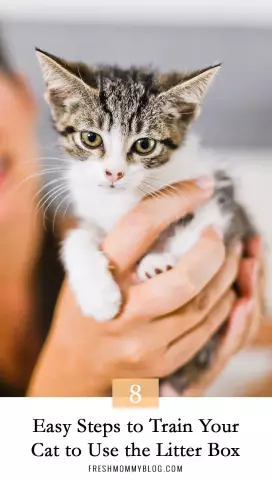- Author Delia Mathews [email protected].
- Public 2023-12-16 00:05.
- Last modified 2025-01-22 15:45.
Taking a kitten into the house, immediately solve the problem with its nutrition and toilet. A baby recently weaned from its mother often does not yet know how to walk in the tray and eat on its own. But, having shown perseverance, you can teach the animal everything you need in a couple of days.

Instructions
Step 1
If the kitten is not familiar with solid foods, teach him to drink milk on his own. It is better to warm it up to room temperature and pour it into a saucer. Place the baby next to the saucer, dip your finger in milk and slide it over the animal's face. The kitten will lick its lips and feel the familiar taste.

Step 2
Place your baby closer to the bowl. Perhaps he will try to lap on his own. If it doesn't, gently dip the kitten's face in the milk. Be careful not to get it in your nose. The first experiments will not be very successful - the animal can back away, snort and scratch. Be persistent, but don't be angry with your pet. Gently push him towards the bowl - soon the kitten will understand what you want from him.

Step 3
It's time to feed a kitten at the age of 1 month with a denser food. The best option for starting complementary foods is canned meat for kittens. Usually, animals are attracted by their smell. Place some pate on your finger and bring it to the animal's mouth, encouraging it to lick the treat. If successful, pet the pet and give him some more canned food. Very soon the kitten will be eating on its own.

Step 4
If the animal prefers liquid food and does not eat kitten food, offer him baby canned meat - they have a lighter consistency. Having started eating meat, the kitten will soon be able to switch to canned cat food, and later - to dry granules. Do not feed the animal with store-bought minced meat, sausages and other foods with a lot of fat and salt. The delicate stomach of the animal can react with upset.

Step 5
Another important point is solving the problem with the toilet. Choose a small tray with low sides for the kitten - it should be comfortable for the baby to climb into it. Pressed sawdust or silica gel are suitable as fillers. Do not use lumpy filler - your baby can lick it off, which can lead to stomach problems.

Step 6
Place the tray in a secluded area. After the pet wakes up, take it to the litter box and hold it there by stroking it. If your toddler goes to the toilet, praise him. Repeat the procedure after each meal - a healthy kitten visits the litter box several times a day.
Step 7
Watch your baby closely in the early days. Usually the kitten understands what they want from him and starts going to the toilet in the designated place. If not, make sure the tray is not obstructed. A teachable spray can be used as an additional stimulant - sprinkle it on the litter from time to time. Remove waste from your pet's pot in a timely manner and wash the litter box at least once a week.






